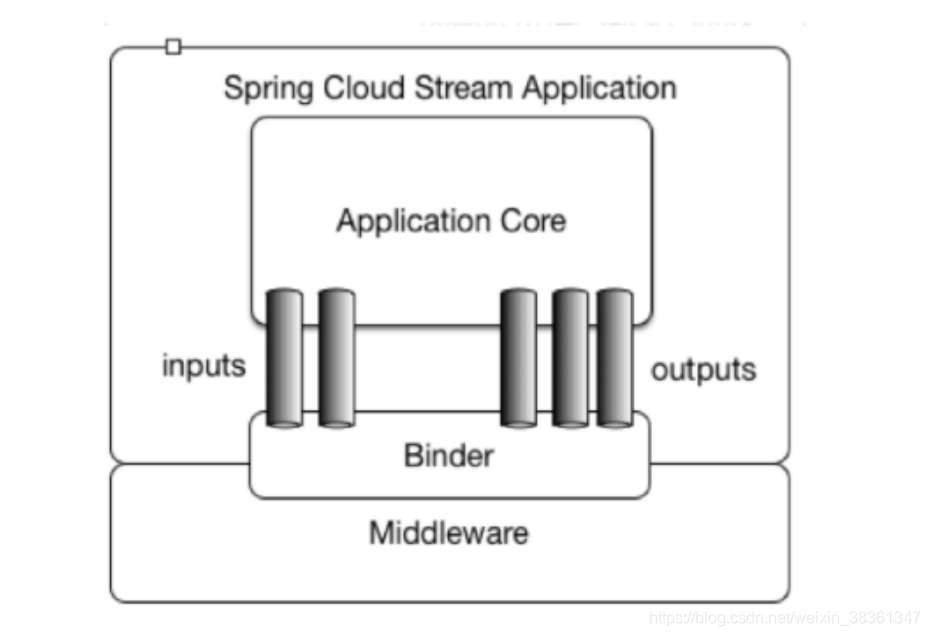前言
Spring Cloud Stream消息驱动组件是 Spring Cloud 中组件之一,通常用来帮助我们更快速的,更方便,更友好,优雅的方式去构建消息驱动微服务。
为什么不直接使用消息队列如ActiveMQ RabbitMQ RocketMQ Kafka等。
而是使用Spring Cloud Stream,它有什么优点,解决了什么样的问题?
Stream解决问题
首先对MQ中间件来说,有很多产品,其中包括ActiveMQ RabbitMQ RocketMQ Kafka等,MQ消息中间件⼴泛应⽤在应⽤解耦合、异步消息处理、流量削峰等场景中。
不同的MQ消息中间件内部机制包括使⽤⽅式都会有所不同,⽐如RabbitMQ中有Exchange(交换机/交换器).
kafka有Topic、Partition分区这些概念,MQ消息中间件之间的差异性不利于我们上层的开发应⽤。如果我们有需要从一个MQ切换到另一个MQ,那对应我们的程序代码也需要进行修改,此时MQ和程序耦合起来了。
此时,Stream就解决了这个问题,底层可以任意切换MQ,目前Stream仅支持RocketMQ 和 Kafka两款MQ产品。
Spring Cloud Stream进⾏了很好的上层抽象、屏蔽掉了底层具体MQ消息中间件的细节差异,就像Hibernate屏蔽掉了具体数
据库(Mysql/Oracle⼀样)。
Stream重要概念
Spring Cloud Stream 是⼀个构建消息驱动微服务的框架。应⽤程序通过inputs(相当于消息消费者consumer)或者outputs(相当于消息⽣产者producer)来与Spring Cloud Stream中的binder对象交互,⽽Binder对象是⽤来屏蔽底层MQ细节的,它负责与具体的消息中间件交互。

Application core: 消费者逻辑代码,生产者逻辑代码
MiddleWare : 对应底层中间件MQ
inputs: 可以用多个input 、关联消费者 输入 相对于程序代码来说 从Mq输入到消费者进行消费。
outputs: 可以用多个output、关联生产者 输出 相对于应用程序来说,从程序输出到mq中。
通道(Binddings): 通道用来跟Binder打交道
Binder: 绑定器对象,用来和底层MQ打交道
传统MQ模型与Stream消息驱动模型

Binder绑定器
Binder绑定器是Spring Cloud Stream 中⾮常核⼼的概念,就是通过它来屏蔽底层不同MQ消息中间件的细节差异,当需要更换为其他消息中间件时,我们需要做的就是更换对应的Binder绑定器⽽不需要修改任何应⽤逻辑(Binder绑定器的实现是框架内置的,Spring Cloud Stream⽬前⽀持Rabbit、Kafka两种消息队列)
Stream消息通信⽅式
Stream中的消息通信⽅式遵循了发布—订阅模式。
在Spring Cloud Stream中的消息通信⽅式遵循了发布-订阅模式,当⼀条消息被投递到消息中间件之 后,它会通过共享的 Topic 主题进⾏⼴播,消息消费者在订阅的主题中收到它并触发⾃身的业务逻辑处理。这⾥所提到的 Topic 主题是SpringCloud Stream中的⼀个抽象概念,⽤来代表发布共享消息给消 费者的地⽅。在不同的消息中间件中, Topic 可能对应着不同的概念,⽐如:在RabbitMQ中的它对应了Exchange、在Kakfa中则对应了Kafka中的Topic。
Stream编程注解

代码示例
首先创建三个工程,服务注册端就不创建了 直接8761
- server_pruduce_stream_server_7100 生产者
- server_consumer_stream_server_7101 消费者
- server_consumer_stream_server_7102 消费者
生产者
依赖
<dependency>
<groupId>org.springframework.cloud</groupId>
<artifactId>spring-cloud-starter-netflix-eureka-client</artifactId>
</dependency>
<!--Config 客户端依赖-->
<dependency>
<groupId>org.springframework.cloud</groupId>
<artifactId>spring-cloud-config-client</artifactId>
</dependency>
<!-- bus自动刷新 -->
<dependency>
<groupId>org.springframework.cloud</groupId>
<artifactId>spring-cloud-starter-bus-amqp</artifactId>
</dependency>
配置输入,以及mq配置
#eureka server服务端口
server:
port: 7100
spring:
application:
name: server-pruduce-stream-server-7100 # 应用名称,应用名称会在Eureka中作为服务名称
cloud:
inetutils:
# 指定此客户端的ip
default-ip-address: springcloud
# stream 配置
stream:
binders: # 绑定MQ服务信息(此处我们是RabbitMQ)
testRabbitBinder: # 给Binder定义的名称,⽤于后⾯的关联
type: rabbit # MQ类型,如果是Kafka的话,此处配置kafka
environment:
spring:
rabbitmq:
# MQ环境配置(⽤户名、密码等)
host: localhost
port: 5672
username: guest
password: guest
bindings: # 关联整合通道和binder对象
output: # output是我们定义的通道名称,此处不能乱改
destination: mqExchange # 要使⽤的Exchange名称(消息队列主题名称)
content-type: text/plain # application/json # 消息类型设置,⽐如json
binder: testRabbitBinder # 关联MQ服务
eureka:
instance:
hostname: springcloud # 当前eureka实例的主机名
ip-address: springcloud
client:
service-url:
prefer-ip-address: true
lease-renewal-interval-in-seconds: 30
# 租约到期,服务时效时间,默认值90秒,服务超过90秒没有发⽣⼼跳,服务注册中心会将服务从列表移除
lease-expiration-duration-in-seconds: 90
# 配置客户端所交互的Eureka Server的地址(Eureka Server集群中每一个Server其实相对于其它Server来说都是Client)
# 集群模式下,defaultZone应该指向其它Eureka Server,如果有更多其它Server实例,逗号拼接即可
defaultZone: http://127.0.0.1:8761/eureka,http://127.0.0.1:8762/eureka # 注册到集群汇总,多个用,拼接
register-with-eureka: true # 集群模式下可以改成true
fetch-registry: true # 集群模式下可以改成true
#建议暴露所有的端⼝
management:
# 暴露健康接口细节
endpoint:
health:
show-details: always
endpoints:
web:
exposure:
include: "*"
消费者代码和配置都一样,只是服务端口不相同
<!--eureka client 客户端依赖引⼊-->
<dependency>
<groupId>org.springframework.cloud</groupId>
<artifactId>spring-cloud-starter-netflix-eureka-client</artifactId>
</dependency>
<!--spring cloud stream 依赖(rabbit)-->
<dependency>
<groupId>org.springframework.cloud</groupId>
<artifactId>spring-cloud-starter-stream-rabbit</artifactId>
</dependency>
消费配置,以及mq配置
#eureka server服务端口
server:
port: 7102
spring:
application:
name: server-pruduce-stream-server-7102 # 应用名称,应用名称会在Eureka中作为服务名称
cloud:
inetutils:
# 指定此客户端的ip
default-ip-address: springcloud
# stream 配置
stream:
binders: # 绑定MQ服务信息(此处我们是RabbitMQ)
testRabbitBinder: # 给Binder定义的名称,⽤于后⾯的关联
type: rabbit # MQ类型,如果是Kafka的话,此处配置kafka
environment: # MQ环境配置(⽤户名、密码等)
spring:
rabbitmq:
host: localhost
port: 5672
username: guest
password: guest
bindings: # 关联整合通道和binder对象
input: # output是我们定义的通道名称,此处不能乱改
destination: mqExchange # 要使⽤的Exchange名称(消息队列主题名称)
content-type: text/plain # application/json # 消息类型设置,⽐如json
binder: testRabbitBinder # 关联MQ服务
#group: input001 # 消费者分组 避免多个消费者重复消费同一个任务
eureka:
instance:
hostname: springcloud # 当前eureka实例的主机名
ip-address: springcloud
client:
service-url:
prefer-ip-address: true
lease-renewal-interval-in-seconds: 30
# 租约到期,服务时效时间,默认值90秒,服务超过90秒没有发⽣⼼跳,服务注册中心会将服务从列表移除
lease-expiration-duration-in-seconds: 90
# 配置客户端所交互的Eureka Server的地址(Eureka Server集群中每一个Server其实相对于其它Server来说都是Client)
# 集群模式下,defaultZone应该指向其它Eureka Server,如果有更多其它Server实例,逗号拼接即可
defaultZone: http://127.0.0.1:8761/eureka,http://127.0.0.1:8762/eureka # 注册到集群汇总,多个用,拼接
register-with-eureka: true # 集群模式下可以改成true
fetch-registry: true # 集群模式下可以改成true
#建议暴露所有的端⼝
management:
# 暴露健康接口细节
endpoint:
health:
show-details: always
endpoints:
web:
exposure:
include: "*"
生产者代码
这儿的Source是stream 定义默认的通道,即配置文件中output配置,用来从代码中输出到mq中
public interface Source {
String OUTPUT = "output";
@Output("output")
MessageChannel output();
}
生产者
@EnableBinding(Source.class)
@Component
public class Pruduce {
// 将MessageChannel的封装对象Source注⼊到这⾥使⽤
@Autowired
private Source source;
public void sendMessage(String content) {
// 向mq中发送消息(并不是直接操作mq,应该操作的是spring cloud stream)
// 使⽤通道向外发出消息(指的是Source⾥⾯的output通道)
source.output().send(MessageBuilder.withPayload(content).build());
}
}
代码消费
绑定消费 通道 input 即是在yml里配置的 、bindings 关联整合通道和binder对象,用来配置从哪个mq 队列获取消息,以及消息的类型
默认配置是
public interface Sink {
String INPUT = "input";
@Input("input")
SubscribableChannel input();
}
绑定消费
@EnableBinding(Sink.class)
@Component
public class ConsumerImpl implements Consumer{
@StreamListener(Sink.INPUT) //用于监听生产者端Message 到来
@Override
public void recevieMessages(Message<String> message) {
System.out.println("=========接收到的消息:" + message);
}
}
分别启动三个服务
生产者 测试
@Autowired
private Pruduce pruduce;
@org.junit.Test
public void test(){
pruduce.sendMessage("hello world...");
}
两个服务消费直接启动服务,使用注解@StreamListener(Sink.INPUT)进行监听某个通道
发现一个生产者两个服务都消费到了
如果不想使用订阅消费者,避免重复消费,可以分组配置,让两个消费者在同一个组里,这样可以避免重复消费。
group: input001 # 消费者分组 避免多个消费者重复消费同一个任务
由于源码中只有一个通道,在业务中不可能所有的业务使用同一个通道,此时源码中不支持我们的业务场景。
所以,我们需要不同的通道,可以自定义不同的生产者和消费者通道,然后在生产和监听获取的时候,使用我们自己的通道即可。
自定义通道
interface CustomChannel {
String INPUT_LOG = "input1";
String OUTPUT_LOG = "output1";
@Input(INPUT_LOG)
SubscribableChannel inputLog();
@Output(OUTPUT_LOG)
MessageChannel outputLog();
}
生产绑定通道 在 @EnableBinding 注解中,绑定⾃定义的接⼝。
@EnableBinding(CustomChannel.class) 然后注入使用
CustomChannel.output().send…
消费监听通道 @StreamListener 做监听的时候,需要指定。
@EnableBinding(CustomChannel.class)
@StreamListener(CustomChannel.INPUT_LOG)





















 190
190











 被折叠的 条评论
为什么被折叠?
被折叠的 条评论
为什么被折叠?








